P35042 Real Estate Investment and Finance: Mitchell & Butcher Report
VerifiedAdded on 2022/10/06
|10
|2105
|255
Report
AI Summary
This report provides a comprehensive financial analysis of Mitchell & Butcher Plc, a UK-based retailer, to assess its investment potential. It examines the company's financial performance, including profitability and solvency ratios, based on data from 2017 and 2018. The analysis reveals a decline in sales and profitability, primarily due to increased expenses, particularly lease charges from the sale of freehold properties. The report investigates both short-term and long-term solvency, highlighting a concerning increase in the debt-to-asset ratio and a poor current ratio, indicating liquidity issues. The conclusion supports the management's decision to close some stores to reduce expenses, but emphasizes the need for increased sales volume to achieve substantial profitability and improve the company's financial position. This analysis is crucial for investors to make informed decisions about supporting the company's strategies and safeguarding their investments.
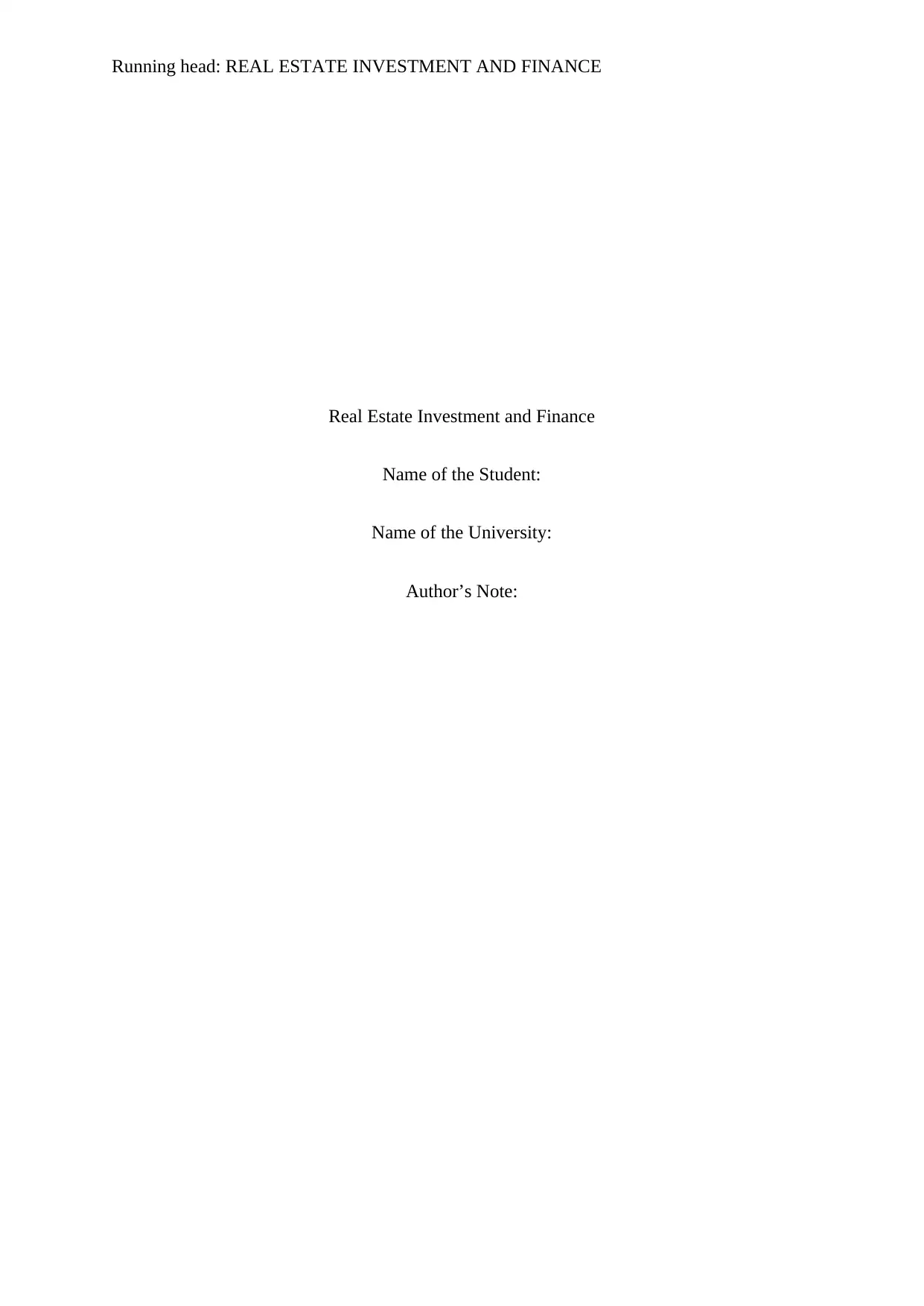
Running head: REAL ESTATE INVESTMENT AND FINANCE
Real Estate Investment and Finance
Name of the Student:
Name of the University:
Author’s Note:
Real Estate Investment and Finance
Name of the Student:
Name of the University:
Author’s Note:
Paraphrase This Document
Need a fresh take? Get an instant paraphrase of this document with our AI Paraphraser
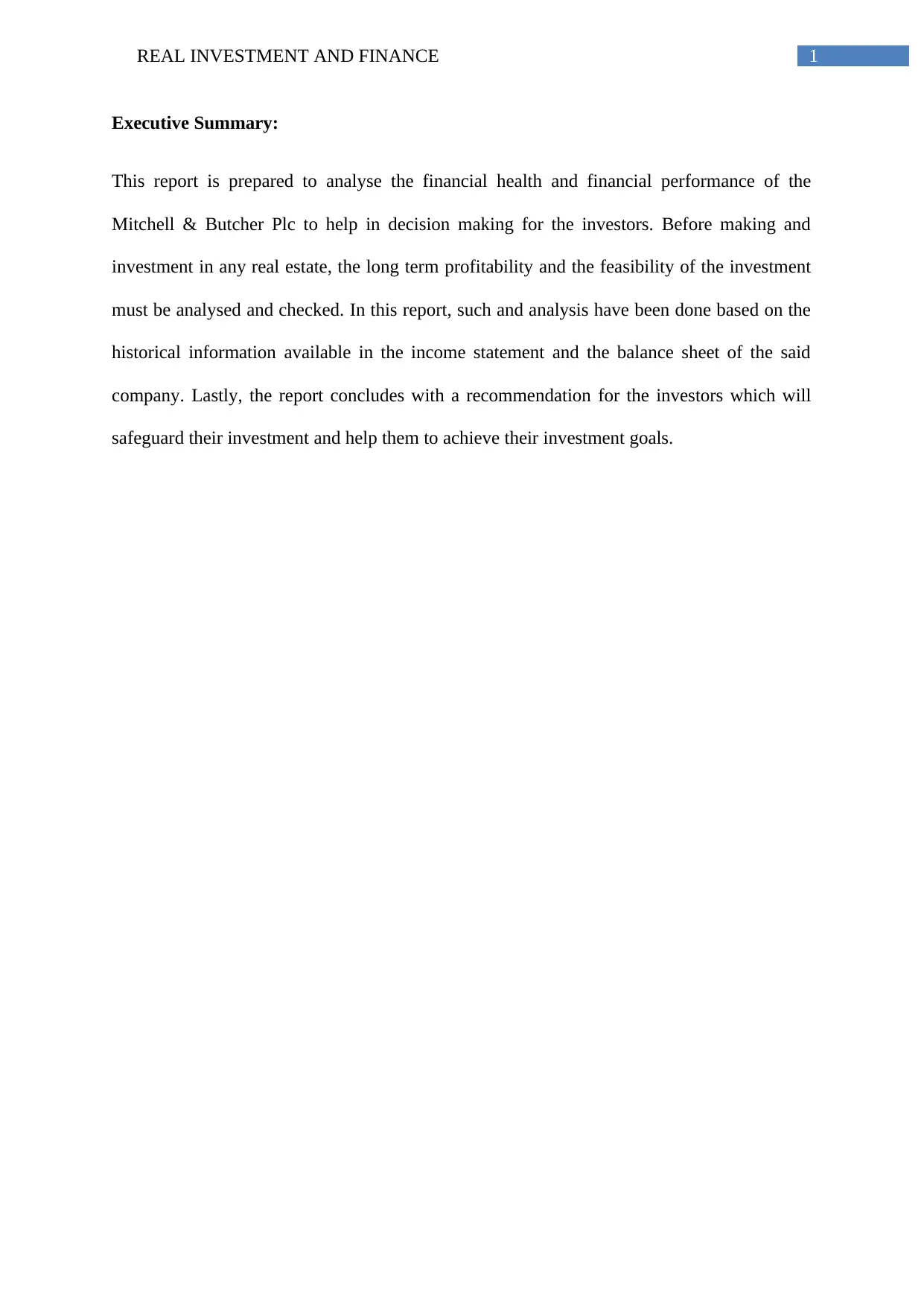
1REAL INVESTMENT AND FINANCE
Executive Summary:
This report is prepared to analyse the financial health and financial performance of the
Mitchell & Butcher Plc to help in decision making for the investors. Before making and
investment in any real estate, the long term profitability and the feasibility of the investment
must be analysed and checked. In this report, such and analysis have been done based on the
historical information available in the income statement and the balance sheet of the said
company. Lastly, the report concludes with a recommendation for the investors which will
safeguard their investment and help them to achieve their investment goals.
Executive Summary:
This report is prepared to analyse the financial health and financial performance of the
Mitchell & Butcher Plc to help in decision making for the investors. Before making and
investment in any real estate, the long term profitability and the feasibility of the investment
must be analysed and checked. In this report, such and analysis have been done based on the
historical information available in the income statement and the balance sheet of the said
company. Lastly, the report concludes with a recommendation for the investors which will
safeguard their investment and help them to achieve their investment goals.
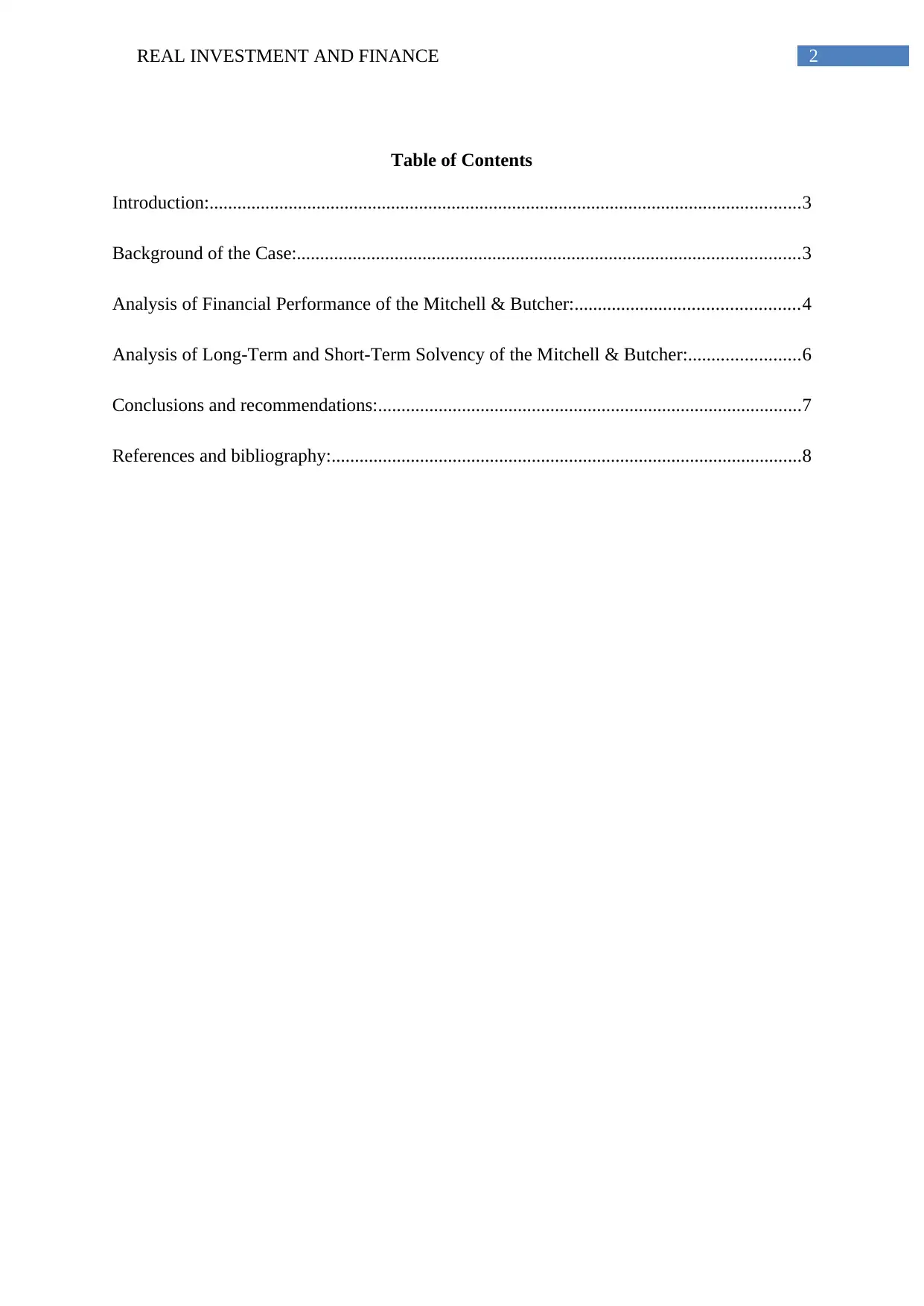
2REAL INVESTMENT AND FINANCE
Table of Contents
Introduction:...............................................................................................................................3
Background of the Case:............................................................................................................3
Analysis of Financial Performance of the Mitchell & Butcher:................................................4
Analysis of Long-Term and Short-Term Solvency of the Mitchell & Butcher:........................6
Conclusions and recommendations:...........................................................................................7
References and bibliography:.....................................................................................................8
Table of Contents
Introduction:...............................................................................................................................3
Background of the Case:............................................................................................................3
Analysis of Financial Performance of the Mitchell & Butcher:................................................4
Analysis of Long-Term and Short-Term Solvency of the Mitchell & Butcher:........................6
Conclusions and recommendations:...........................................................................................7
References and bibliography:.....................................................................................................8
⊘ This is a preview!⊘
Do you want full access?
Subscribe today to unlock all pages.

Trusted by 1+ million students worldwide
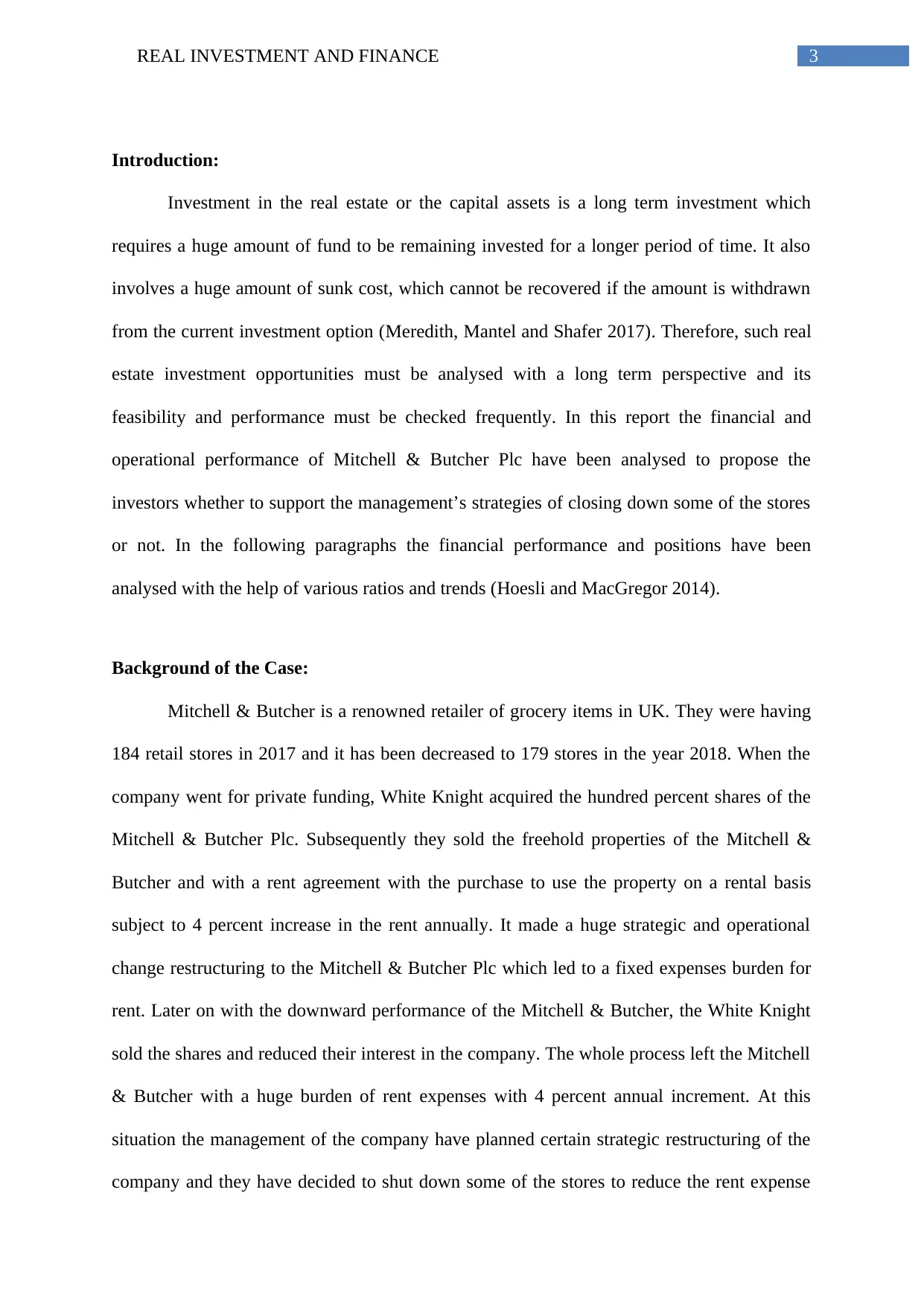
3REAL INVESTMENT AND FINANCE
Introduction:
Investment in the real estate or the capital assets is a long term investment which
requires a huge amount of fund to be remaining invested for a longer period of time. It also
involves a huge amount of sunk cost, which cannot be recovered if the amount is withdrawn
from the current investment option (Meredith, Mantel and Shafer 2017). Therefore, such real
estate investment opportunities must be analysed with a long term perspective and its
feasibility and performance must be checked frequently. In this report the financial and
operational performance of Mitchell & Butcher Plc have been analysed to propose the
investors whether to support the management’s strategies of closing down some of the stores
or not. In the following paragraphs the financial performance and positions have been
analysed with the help of various ratios and trends (Hoesli and MacGregor 2014).
Background of the Case:
Mitchell & Butcher is a renowned retailer of grocery items in UK. They were having
184 retail stores in 2017 and it has been decreased to 179 stores in the year 2018. When the
company went for private funding, White Knight acquired the hundred percent shares of the
Mitchell & Butcher Plc. Subsequently they sold the freehold properties of the Mitchell &
Butcher and with a rent agreement with the purchase to use the property on a rental basis
subject to 4 percent increase in the rent annually. It made a huge strategic and operational
change restructuring to the Mitchell & Butcher Plc which led to a fixed expenses burden for
rent. Later on with the downward performance of the Mitchell & Butcher, the White Knight
sold the shares and reduced their interest in the company. The whole process left the Mitchell
& Butcher with a huge burden of rent expenses with 4 percent annual increment. At this
situation the management of the company have planned certain strategic restructuring of the
company and they have decided to shut down some of the stores to reduce the rent expense
Introduction:
Investment in the real estate or the capital assets is a long term investment which
requires a huge amount of fund to be remaining invested for a longer period of time. It also
involves a huge amount of sunk cost, which cannot be recovered if the amount is withdrawn
from the current investment option (Meredith, Mantel and Shafer 2017). Therefore, such real
estate investment opportunities must be analysed with a long term perspective and its
feasibility and performance must be checked frequently. In this report the financial and
operational performance of Mitchell & Butcher Plc have been analysed to propose the
investors whether to support the management’s strategies of closing down some of the stores
or not. In the following paragraphs the financial performance and positions have been
analysed with the help of various ratios and trends (Hoesli and MacGregor 2014).
Background of the Case:
Mitchell & Butcher is a renowned retailer of grocery items in UK. They were having
184 retail stores in 2017 and it has been decreased to 179 stores in the year 2018. When the
company went for private funding, White Knight acquired the hundred percent shares of the
Mitchell & Butcher Plc. Subsequently they sold the freehold properties of the Mitchell &
Butcher and with a rent agreement with the purchase to use the property on a rental basis
subject to 4 percent increase in the rent annually. It made a huge strategic and operational
change restructuring to the Mitchell & Butcher Plc which led to a fixed expenses burden for
rent. Later on with the downward performance of the Mitchell & Butcher, the White Knight
sold the shares and reduced their interest in the company. The whole process left the Mitchell
& Butcher with a huge burden of rent expenses with 4 percent annual increment. At this
situation the management of the company have planned certain strategic restructuring of the
company and they have decided to shut down some of the stores to reduce the rent expense
Paraphrase This Document
Need a fresh take? Get an instant paraphrase of this document with our AI Paraphraser
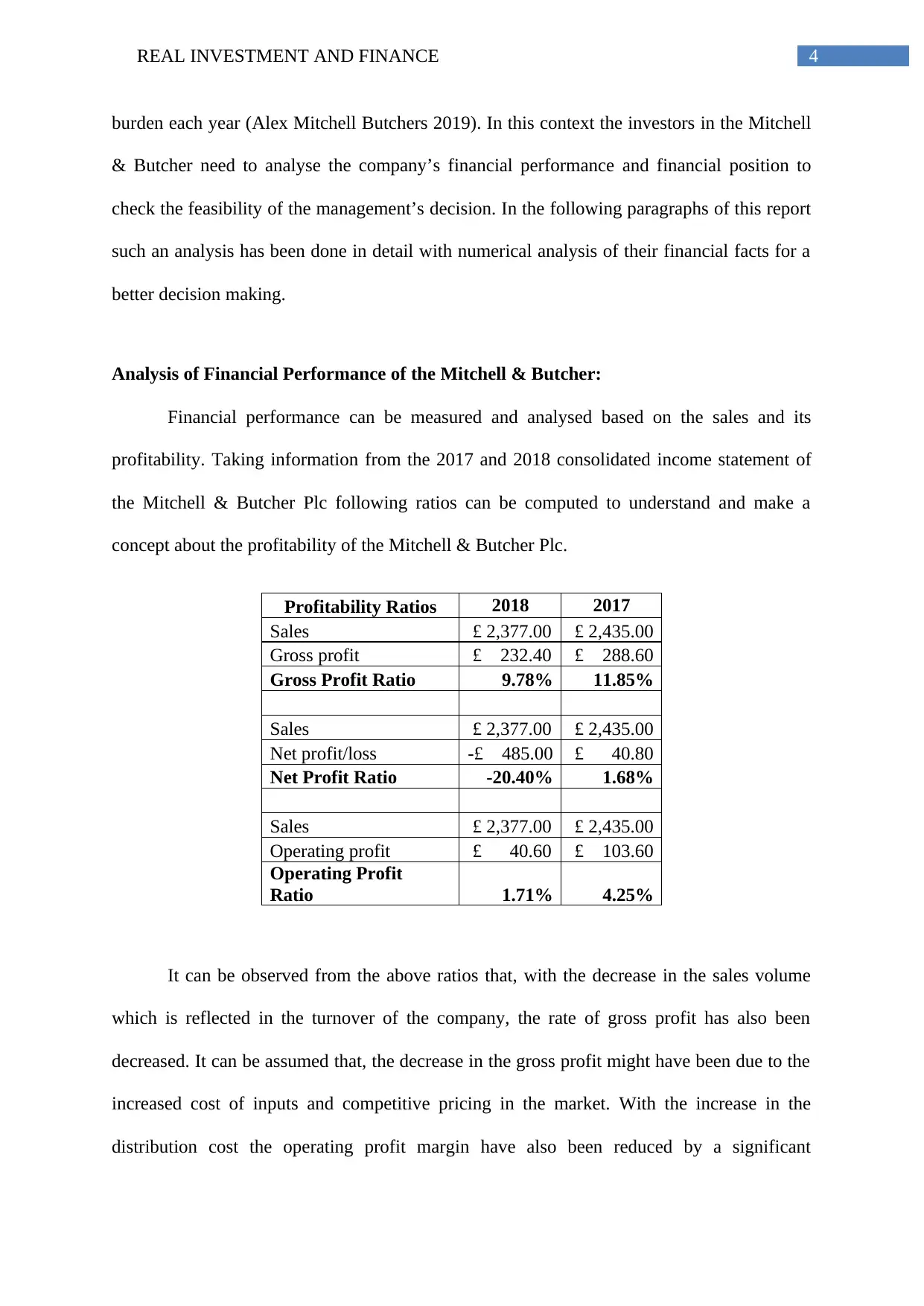
4REAL INVESTMENT AND FINANCE
burden each year (Alex Mitchell Butchers 2019). In this context the investors in the Mitchell
& Butcher need to analyse the company’s financial performance and financial position to
check the feasibility of the management’s decision. In the following paragraphs of this report
such an analysis has been done in detail with numerical analysis of their financial facts for a
better decision making.
Analysis of Financial Performance of the Mitchell & Butcher:
Financial performance can be measured and analysed based on the sales and its
profitability. Taking information from the 2017 and 2018 consolidated income statement of
the Mitchell & Butcher Plc following ratios can be computed to understand and make a
concept about the profitability of the Mitchell & Butcher Plc.
Profitability Ratios 2018 2017
Sales £ 2,377.00 £ 2,435.00
Gross profit £ 232.40 £ 288.60
Gross Profit Ratio 9.78% 11.85%
Sales £ 2,377.00 £ 2,435.00
Net profit/loss -£ 485.00 £ 40.80
Net Profit Ratio -20.40% 1.68%
Sales £ 2,377.00 £ 2,435.00
Operating profit £ 40.60 £ 103.60
Operating Profit
Ratio 1.71% 4.25%
It can be observed from the above ratios that, with the decrease in the sales volume
which is reflected in the turnover of the company, the rate of gross profit has also been
decreased. It can be assumed that, the decrease in the gross profit might have been due to the
increased cost of inputs and competitive pricing in the market. With the increase in the
distribution cost the operating profit margin have also been reduced by a significant
burden each year (Alex Mitchell Butchers 2019). In this context the investors in the Mitchell
& Butcher need to analyse the company’s financial performance and financial position to
check the feasibility of the management’s decision. In the following paragraphs of this report
such an analysis has been done in detail with numerical analysis of their financial facts for a
better decision making.
Analysis of Financial Performance of the Mitchell & Butcher:
Financial performance can be measured and analysed based on the sales and its
profitability. Taking information from the 2017 and 2018 consolidated income statement of
the Mitchell & Butcher Plc following ratios can be computed to understand and make a
concept about the profitability of the Mitchell & Butcher Plc.
Profitability Ratios 2018 2017
Sales £ 2,377.00 £ 2,435.00
Gross profit £ 232.40 £ 288.60
Gross Profit Ratio 9.78% 11.85%
Sales £ 2,377.00 £ 2,435.00
Net profit/loss -£ 485.00 £ 40.80
Net Profit Ratio -20.40% 1.68%
Sales £ 2,377.00 £ 2,435.00
Operating profit £ 40.60 £ 103.60
Operating Profit
Ratio 1.71% 4.25%
It can be observed from the above ratios that, with the decrease in the sales volume
which is reflected in the turnover of the company, the rate of gross profit has also been
decreased. It can be assumed that, the decrease in the gross profit might have been due to the
increased cost of inputs and competitive pricing in the market. With the increase in the
distribution cost the operating profit margin have also been reduced by a significant
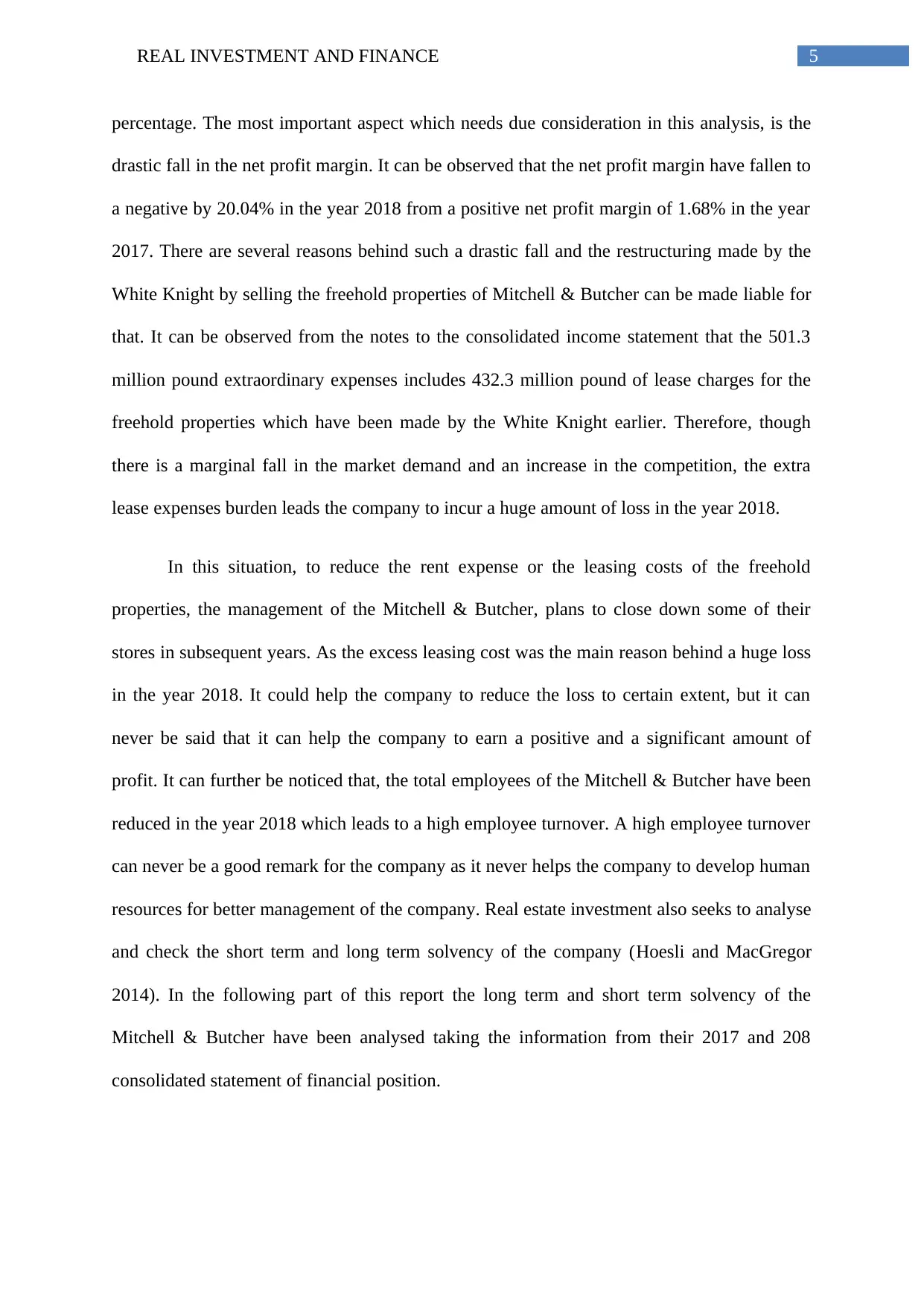
5REAL INVESTMENT AND FINANCE
percentage. The most important aspect which needs due consideration in this analysis, is the
drastic fall in the net profit margin. It can be observed that the net profit margin have fallen to
a negative by 20.04% in the year 2018 from a positive net profit margin of 1.68% in the year
2017. There are several reasons behind such a drastic fall and the restructuring made by the
White Knight by selling the freehold properties of Mitchell & Butcher can be made liable for
that. It can be observed from the notes to the consolidated income statement that the 501.3
million pound extraordinary expenses includes 432.3 million pound of lease charges for the
freehold properties which have been made by the White Knight earlier. Therefore, though
there is a marginal fall in the market demand and an increase in the competition, the extra
lease expenses burden leads the company to incur a huge amount of loss in the year 2018.
In this situation, to reduce the rent expense or the leasing costs of the freehold
properties, the management of the Mitchell & Butcher, plans to close down some of their
stores in subsequent years. As the excess leasing cost was the main reason behind a huge loss
in the year 2018. It could help the company to reduce the loss to certain extent, but it can
never be said that it can help the company to earn a positive and a significant amount of
profit. It can further be noticed that, the total employees of the Mitchell & Butcher have been
reduced in the year 2018 which leads to a high employee turnover. A high employee turnover
can never be a good remark for the company as it never helps the company to develop human
resources for better management of the company. Real estate investment also seeks to analyse
and check the short term and long term solvency of the company (Hoesli and MacGregor
2014). In the following part of this report the long term and short term solvency of the
Mitchell & Butcher have been analysed taking the information from their 2017 and 208
consolidated statement of financial position.
percentage. The most important aspect which needs due consideration in this analysis, is the
drastic fall in the net profit margin. It can be observed that the net profit margin have fallen to
a negative by 20.04% in the year 2018 from a positive net profit margin of 1.68% in the year
2017. There are several reasons behind such a drastic fall and the restructuring made by the
White Knight by selling the freehold properties of Mitchell & Butcher can be made liable for
that. It can be observed from the notes to the consolidated income statement that the 501.3
million pound extraordinary expenses includes 432.3 million pound of lease charges for the
freehold properties which have been made by the White Knight earlier. Therefore, though
there is a marginal fall in the market demand and an increase in the competition, the extra
lease expenses burden leads the company to incur a huge amount of loss in the year 2018.
In this situation, to reduce the rent expense or the leasing costs of the freehold
properties, the management of the Mitchell & Butcher, plans to close down some of their
stores in subsequent years. As the excess leasing cost was the main reason behind a huge loss
in the year 2018. It could help the company to reduce the loss to certain extent, but it can
never be said that it can help the company to earn a positive and a significant amount of
profit. It can further be noticed that, the total employees of the Mitchell & Butcher have been
reduced in the year 2018 which leads to a high employee turnover. A high employee turnover
can never be a good remark for the company as it never helps the company to develop human
resources for better management of the company. Real estate investment also seeks to analyse
and check the short term and long term solvency of the company (Hoesli and MacGregor
2014). In the following part of this report the long term and short term solvency of the
Mitchell & Butcher have been analysed taking the information from their 2017 and 208
consolidated statement of financial position.
⊘ This is a preview!⊘
Do you want full access?
Subscribe today to unlock all pages.

Trusted by 1+ million students worldwide
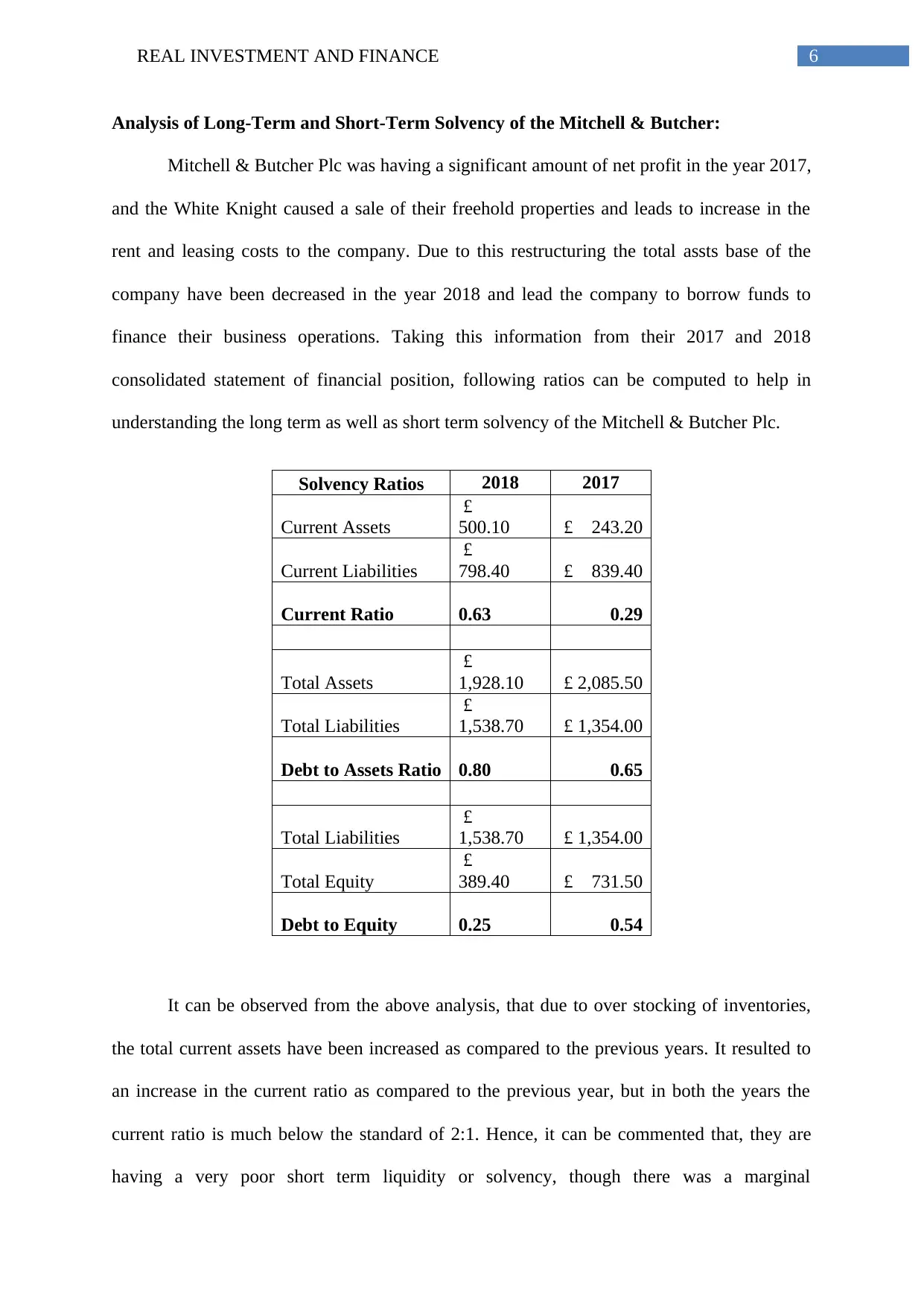
6REAL INVESTMENT AND FINANCE
Analysis of Long-Term and Short-Term Solvency of the Mitchell & Butcher:
Mitchell & Butcher Plc was having a significant amount of net profit in the year 2017,
and the White Knight caused a sale of their freehold properties and leads to increase in the
rent and leasing costs to the company. Due to this restructuring the total assts base of the
company have been decreased in the year 2018 and lead the company to borrow funds to
finance their business operations. Taking this information from their 2017 and 2018
consolidated statement of financial position, following ratios can be computed to help in
understanding the long term as well as short term solvency of the Mitchell & Butcher Plc.
Solvency Ratios 2018 2017
Current Assets
£
500.10 £ 243.20
Current Liabilities
£
798.40 £ 839.40
Current Ratio 0.63 0.29
Total Assets
£
1,928.10 £ 2,085.50
Total Liabilities
£
1,538.70 £ 1,354.00
Debt to Assets Ratio 0.80 0.65
Total Liabilities
£
1,538.70 £ 1,354.00
Total Equity
£
389.40 £ 731.50
Debt to Equity 0.25 0.54
It can be observed from the above analysis, that due to over stocking of inventories,
the total current assets have been increased as compared to the previous years. It resulted to
an increase in the current ratio as compared to the previous year, but in both the years the
current ratio is much below the standard of 2:1. Hence, it can be commented that, they are
having a very poor short term liquidity or solvency, though there was a marginal
Analysis of Long-Term and Short-Term Solvency of the Mitchell & Butcher:
Mitchell & Butcher Plc was having a significant amount of net profit in the year 2017,
and the White Knight caused a sale of their freehold properties and leads to increase in the
rent and leasing costs to the company. Due to this restructuring the total assts base of the
company have been decreased in the year 2018 and lead the company to borrow funds to
finance their business operations. Taking this information from their 2017 and 2018
consolidated statement of financial position, following ratios can be computed to help in
understanding the long term as well as short term solvency of the Mitchell & Butcher Plc.
Solvency Ratios 2018 2017
Current Assets
£
500.10 £ 243.20
Current Liabilities
£
798.40 £ 839.40
Current Ratio 0.63 0.29
Total Assets
£
1,928.10 £ 2,085.50
Total Liabilities
£
1,538.70 £ 1,354.00
Debt to Assets Ratio 0.80 0.65
Total Liabilities
£
1,538.70 £ 1,354.00
Total Equity
£
389.40 £ 731.50
Debt to Equity 0.25 0.54
It can be observed from the above analysis, that due to over stocking of inventories,
the total current assets have been increased as compared to the previous years. It resulted to
an increase in the current ratio as compared to the previous year, but in both the years the
current ratio is much below the standard of 2:1. Hence, it can be commented that, they are
having a very poor short term liquidity or solvency, though there was a marginal
Paraphrase This Document
Need a fresh take? Get an instant paraphrase of this document with our AI Paraphraser
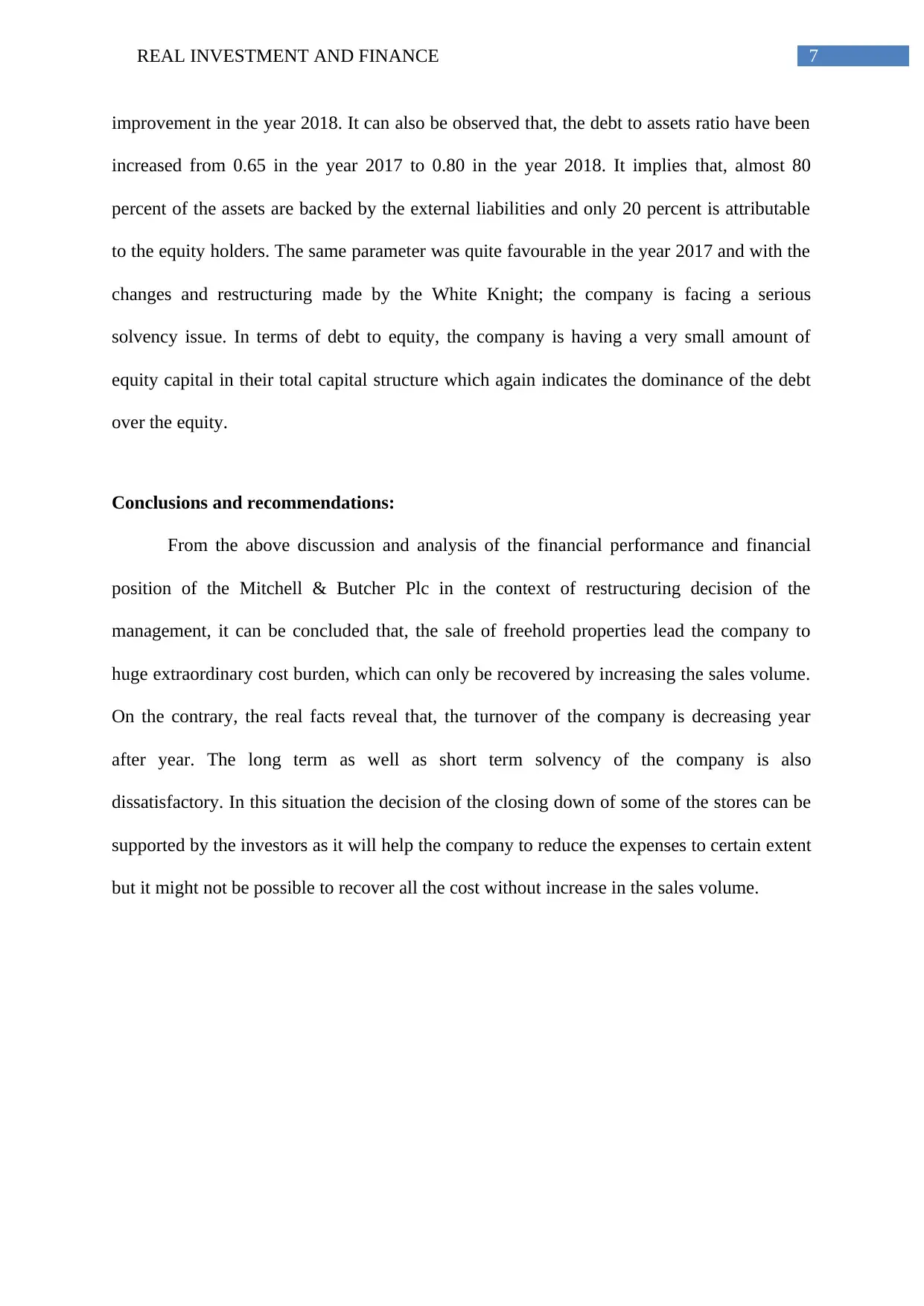
7REAL INVESTMENT AND FINANCE
improvement in the year 2018. It can also be observed that, the debt to assets ratio have been
increased from 0.65 in the year 2017 to 0.80 in the year 2018. It implies that, almost 80
percent of the assets are backed by the external liabilities and only 20 percent is attributable
to the equity holders. The same parameter was quite favourable in the year 2017 and with the
changes and restructuring made by the White Knight; the company is facing a serious
solvency issue. In terms of debt to equity, the company is having a very small amount of
equity capital in their total capital structure which again indicates the dominance of the debt
over the equity.
Conclusions and recommendations:
From the above discussion and analysis of the financial performance and financial
position of the Mitchell & Butcher Plc in the context of restructuring decision of the
management, it can be concluded that, the sale of freehold properties lead the company to
huge extraordinary cost burden, which can only be recovered by increasing the sales volume.
On the contrary, the real facts reveal that, the turnover of the company is decreasing year
after year. The long term as well as short term solvency of the company is also
dissatisfactory. In this situation the decision of the closing down of some of the stores can be
supported by the investors as it will help the company to reduce the expenses to certain extent
but it might not be possible to recover all the cost without increase in the sales volume.
improvement in the year 2018. It can also be observed that, the debt to assets ratio have been
increased from 0.65 in the year 2017 to 0.80 in the year 2018. It implies that, almost 80
percent of the assets are backed by the external liabilities and only 20 percent is attributable
to the equity holders. The same parameter was quite favourable in the year 2017 and with the
changes and restructuring made by the White Knight; the company is facing a serious
solvency issue. In terms of debt to equity, the company is having a very small amount of
equity capital in their total capital structure which again indicates the dominance of the debt
over the equity.
Conclusions and recommendations:
From the above discussion and analysis of the financial performance and financial
position of the Mitchell & Butcher Plc in the context of restructuring decision of the
management, it can be concluded that, the sale of freehold properties lead the company to
huge extraordinary cost burden, which can only be recovered by increasing the sales volume.
On the contrary, the real facts reveal that, the turnover of the company is decreasing year
after year. The long term as well as short term solvency of the company is also
dissatisfactory. In this situation the decision of the closing down of some of the stores can be
supported by the investors as it will help the company to reduce the expenses to certain extent
but it might not be possible to recover all the cost without increase in the sales volume.
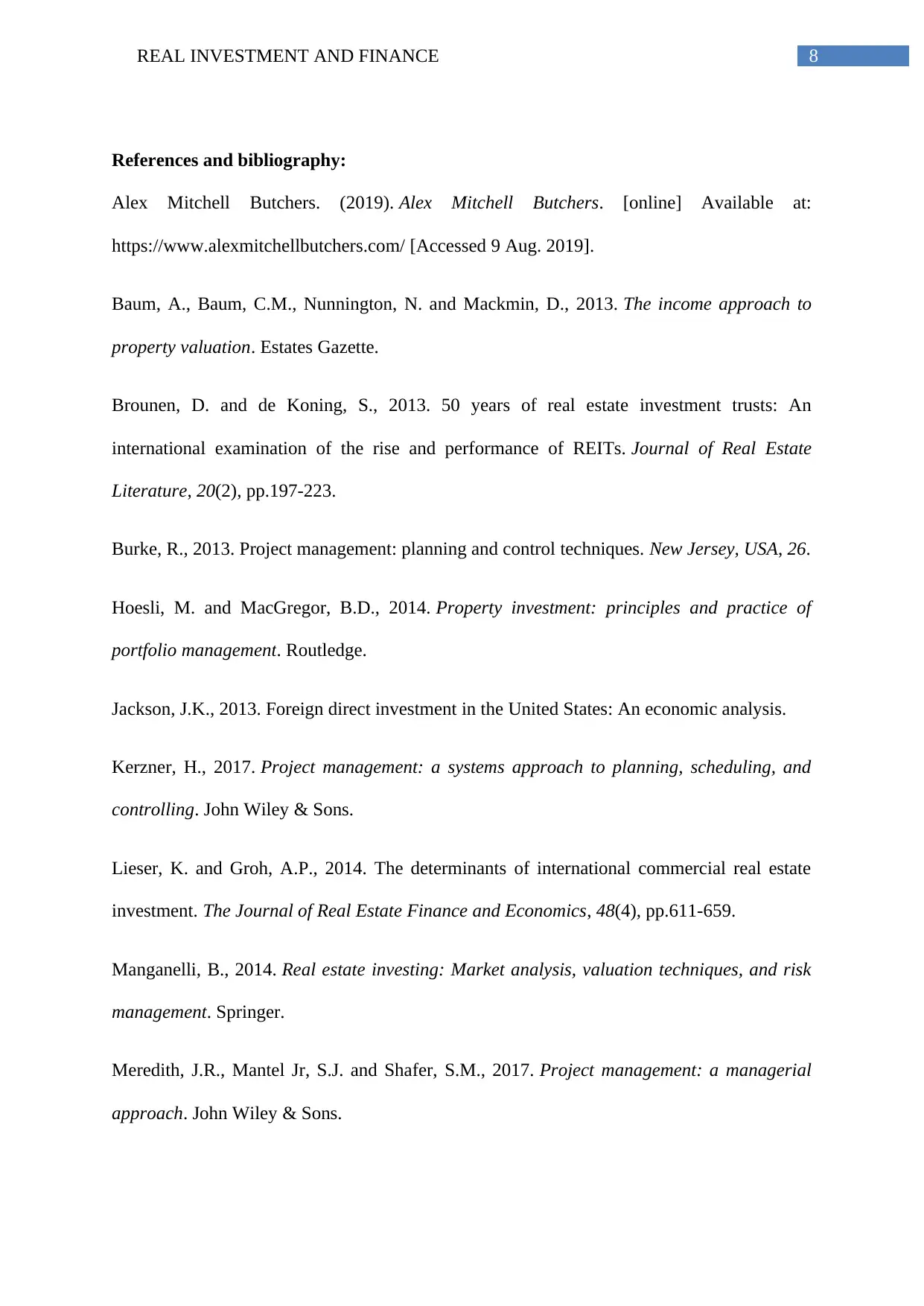
8REAL INVESTMENT AND FINANCE
References and bibliography:
Alex Mitchell Butchers. (2019). Alex Mitchell Butchers. [online] Available at:
https://www.alexmitchellbutchers.com/ [Accessed 9 Aug. 2019].
Baum, A., Baum, C.M., Nunnington, N. and Mackmin, D., 2013. The income approach to
property valuation. Estates Gazette.
Brounen, D. and de Koning, S., 2013. 50 years of real estate investment trusts: An
international examination of the rise and performance of REITs. Journal of Real Estate
Literature, 20(2), pp.197-223.
Burke, R., 2013. Project management: planning and control techniques. New Jersey, USA, 26.
Hoesli, M. and MacGregor, B.D., 2014. Property investment: principles and practice of
portfolio management. Routledge.
Jackson, J.K., 2013. Foreign direct investment in the United States: An economic analysis.
Kerzner, H., 2017. Project management: a systems approach to planning, scheduling, and
controlling. John Wiley & Sons.
Lieser, K. and Groh, A.P., 2014. The determinants of international commercial real estate
investment. The Journal of Real Estate Finance and Economics, 48(4), pp.611-659.
Manganelli, B., 2014. Real estate investing: Market analysis, valuation techniques, and risk
management. Springer.
Meredith, J.R., Mantel Jr, S.J. and Shafer, S.M., 2017. Project management: a managerial
approach. John Wiley & Sons.
References and bibliography:
Alex Mitchell Butchers. (2019). Alex Mitchell Butchers. [online] Available at:
https://www.alexmitchellbutchers.com/ [Accessed 9 Aug. 2019].
Baum, A., Baum, C.M., Nunnington, N. and Mackmin, D., 2013. The income approach to
property valuation. Estates Gazette.
Brounen, D. and de Koning, S., 2013. 50 years of real estate investment trusts: An
international examination of the rise and performance of REITs. Journal of Real Estate
Literature, 20(2), pp.197-223.
Burke, R., 2013. Project management: planning and control techniques. New Jersey, USA, 26.
Hoesli, M. and MacGregor, B.D., 2014. Property investment: principles and practice of
portfolio management. Routledge.
Jackson, J.K., 2013. Foreign direct investment in the United States: An economic analysis.
Kerzner, H., 2017. Project management: a systems approach to planning, scheduling, and
controlling. John Wiley & Sons.
Lieser, K. and Groh, A.P., 2014. The determinants of international commercial real estate
investment. The Journal of Real Estate Finance and Economics, 48(4), pp.611-659.
Manganelli, B., 2014. Real estate investing: Market analysis, valuation techniques, and risk
management. Springer.
Meredith, J.R., Mantel Jr, S.J. and Shafer, S.M., 2017. Project management: a managerial
approach. John Wiley & Sons.
⊘ This is a preview!⊘
Do you want full access?
Subscribe today to unlock all pages.

Trusted by 1+ million students worldwide
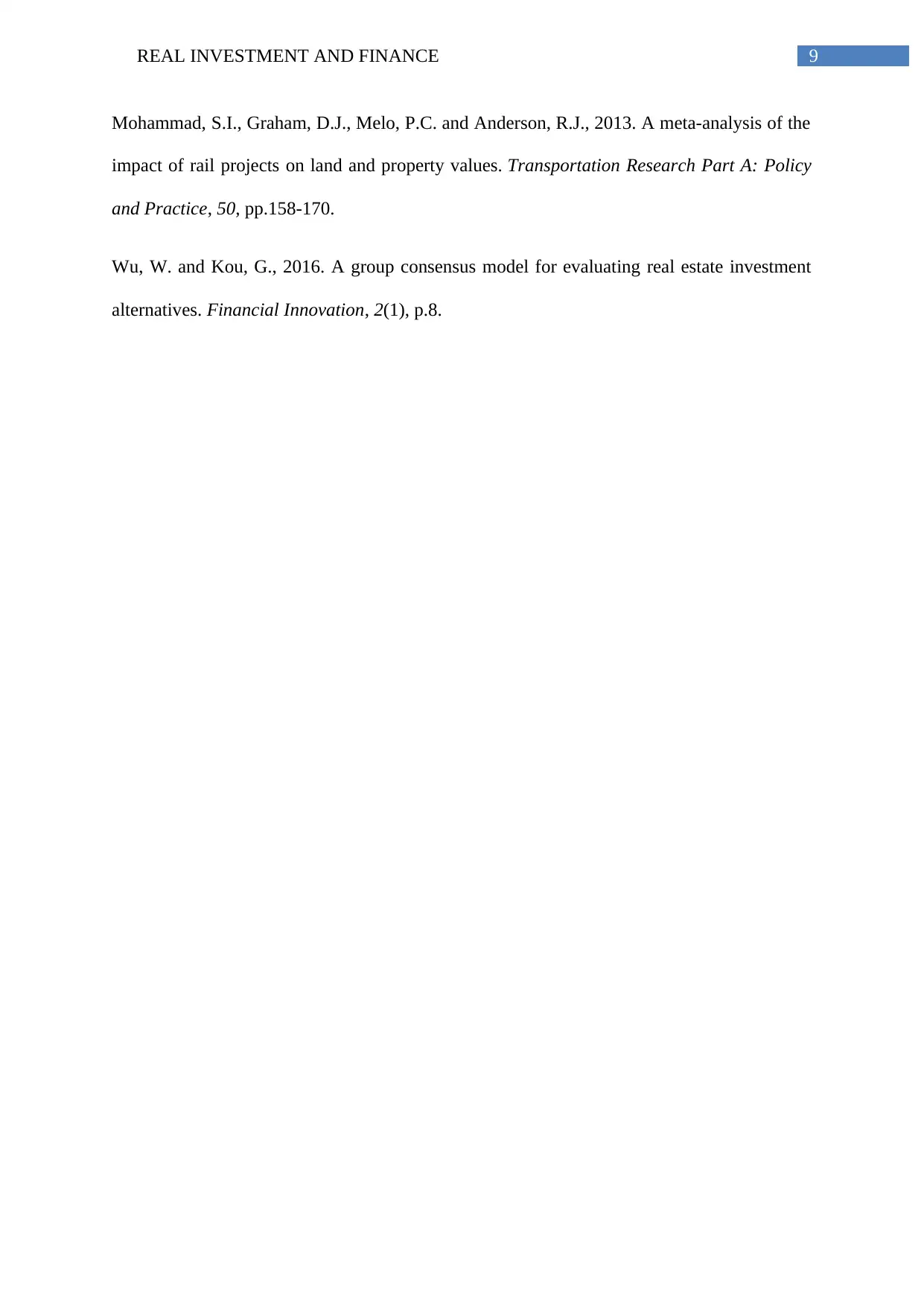
9REAL INVESTMENT AND FINANCE
Mohammad, S.I., Graham, D.J., Melo, P.C. and Anderson, R.J., 2013. A meta-analysis of the
impact of rail projects on land and property values. Transportation Research Part A: Policy
and Practice, 50, pp.158-170.
Wu, W. and Kou, G., 2016. A group consensus model for evaluating real estate investment
alternatives. Financial Innovation, 2(1), p.8.
Mohammad, S.I., Graham, D.J., Melo, P.C. and Anderson, R.J., 2013. A meta-analysis of the
impact of rail projects on land and property values. Transportation Research Part A: Policy
and Practice, 50, pp.158-170.
Wu, W. and Kou, G., 2016. A group consensus model for evaluating real estate investment
alternatives. Financial Innovation, 2(1), p.8.
1 out of 10
Related Documents
Your All-in-One AI-Powered Toolkit for Academic Success.
+13062052269
info@desklib.com
Available 24*7 on WhatsApp / Email
![[object Object]](/_next/static/media/star-bottom.7253800d.svg)
Unlock your academic potential
Copyright © 2020–2025 A2Z Services. All Rights Reserved. Developed and managed by ZUCOL.



